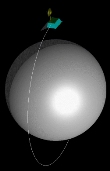Planetary Orbiter
Summary
The Planetary Orbiter is dedicated to remote sensing. To ensure complete coverage of the planet it needs to have a polar orbit. The orbit's pericentre altitude of 400 km and apocentre altitude of 1500 km together with an orbital period of 2.3 hours, will provide an adequate shift of the ground track between successive orbits.
 |
|
Orbit illustration |
The Planetary Orbiter also carries an instrument complement dedicated to radio science. This requires an accuracy of the order of one arcsecond and one metre for the reconstitution of the attitude and orbit, which are derived from measurements provided by the accelerometer, star sensor and multiple-frequency Doppler tracking and ranging.
From pole to pole
To examine the planet from an orbit over the poles, the Planetary Orbiter will have a wide-angle and a narrow-angle camera working by visible and near-infrared light.
Infrared and ultraviolet spectrometers will ananlyse minerals at the surface and constituents of Mercury's tenuous atmosphere, while X-rays and gamma rays will reveal to other instruments the chemical composition of Mercury's soil. A neutron spectrometer will search for water-ice deposits beneath the surface. The Sun's activity, evident in its emissions of X-rays, will be recorded by a solar monitor.
Global mapping of Mercury's gravity by an accelerometer in the Planetary Orbiter forms part of a radio science experiment. This will follow up the link between gravity and Mercury's behaviour in orbit, first explained by Einstein. Provided the spacecraft's motions and attitude and the pressure of sunlight can be gauged with high precision, careful monitoring of radio signals from BepiColombo will provide new tests of the most fundamental aspects of the theory of general relativity.
Table of instruments
The scientific instruments onboard of the Planetary Orbiter.
|
Acronym |
Instrument |
Range |
|
NAC |
Narrow angle camera |
350-1050 nm |
|
WAC |
Wide angle camera |
350-1050 nm |
|
IRS |
Infrared spectrometer |
0.8-2.8 µm |
|
ALI |
UV spectrometer |
70-330 nm |
|
MXS |
Mercury X-ray spectrometer |
0.5-10 keV |
|
MGS |
Mercury gamma-ray spectrometer |
0.1-8 MeV |
|
MNS |
Mercury neutron spectrometer |
0.01-5 MeV |
|
RAD |
Radioscience (two instruments) | |
|
- KAT |
Ka/Ka band transponder |
32-34 GHz |
|
- ISA |
Accelerometer |
10-4-10 Hz |
|
TOP |
Laser altimeter |
1064 ± 5 nm |
|
NET |
Near-Earth Objects Telescope |
18 mag |
Instrument objectives
|
|
NAC |
WAC |
IRS |
ALI |
MXS |
MGS |
MNS |
RAD |
TOP |
NET |
|
Morphology |
X |
X |
|
|
|
|
|
X |
X |
|
|
Internal structure |
|
|
|
|
|
|
|
X |
|
X |
|
Composition |
|
|
|
X |
X |
X |
X |
|
|
|
|
Mineralogy |
X |
X |
X |
|
|
|
|
|
|
|
|
Exosphere |
|
X |
|
X |
|
|
|
|
|
|
|
Fundamental science |
|
|
|
|
|
|
|
X |
|
|
|
Near-Earth Objects |
|
|
|
|
|
|
|
|
|
X |
RAD is the acronym for RADioscience that comprises the two instruments KAT and ISA.
